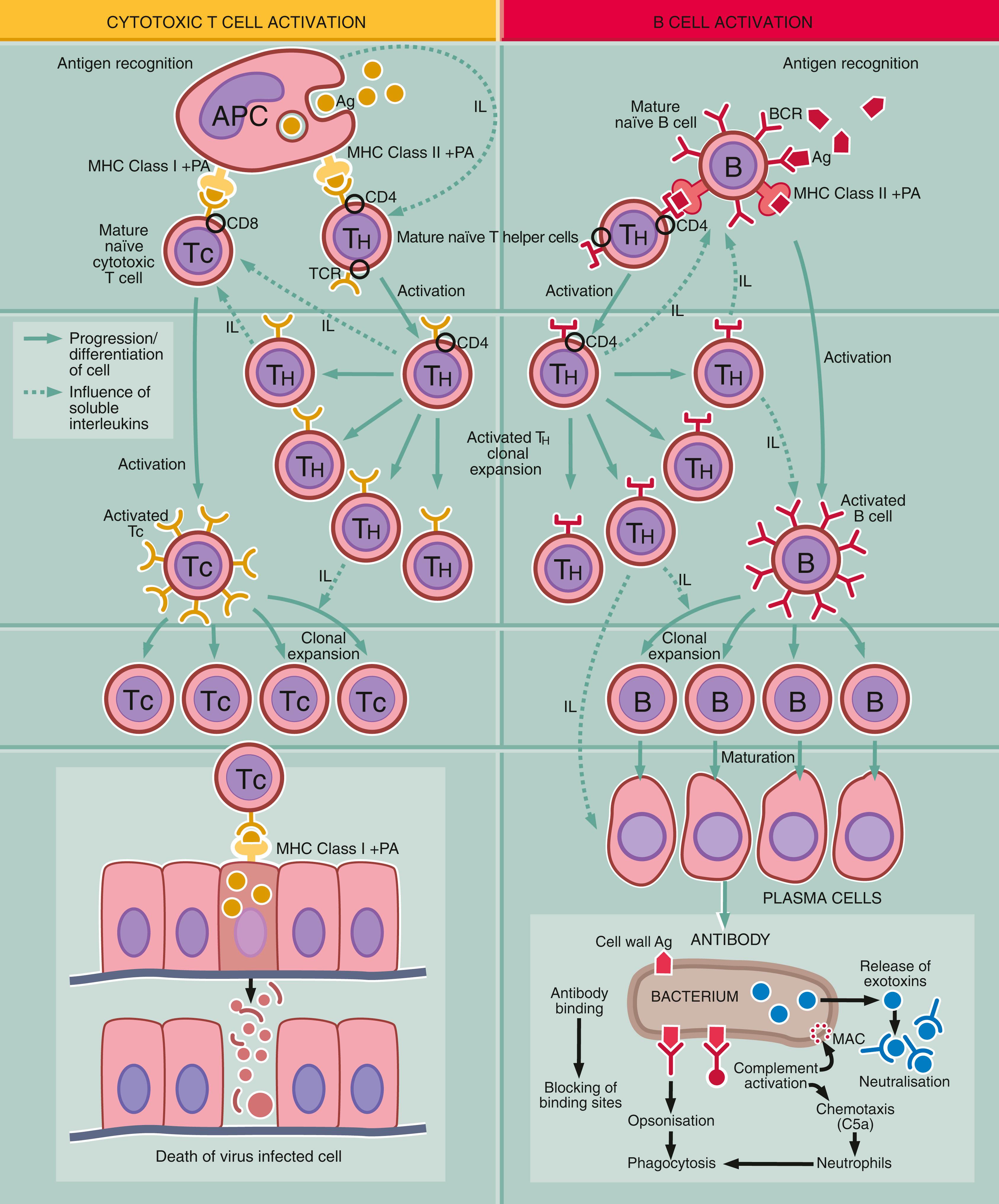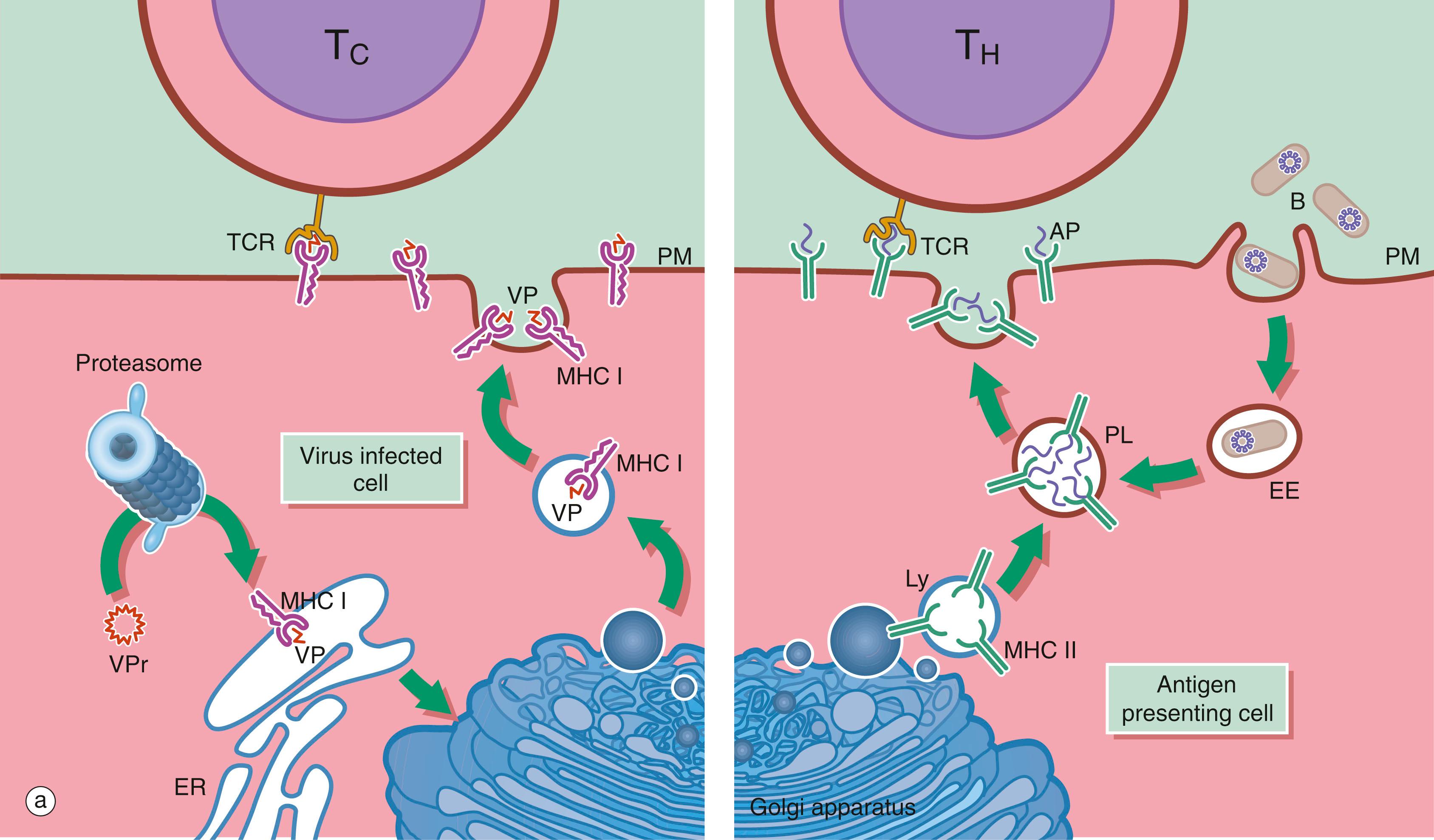Physical Address
304 North Cardinal St.
Dorchester Center, MA 02124
All living tissues are subject to the constant threat of invasion by disease-producing foreign agents and microorganisms (pathogens), i.e. bacteria, viruses, fungi, protozoa and multicellular parasites such as worms. These organisms may invade the body, multiply and destroy functional tissue, causing illness and potentially death. Three main lines of defense have consequently evolved:
Protective surface mechanisms
The innate immune system
The adaptive immune system
These provide the first line of defense and, while intact, provide excellent protection from many disease-causing organisms. However, pathogens may enter the body via breaches in the skin or mucosal linings of the gut, respiratory and genitourinary tracts. The skin, with its surface layer of keratin, constitutes an impenetrable barrier to most microorganisms, unless breached by injury such as abrasion or burning. The mucous surfaces of the body, such as the conjunctiva and oral cavity, are protected by a variety of antibacterial substances including defensins , short antimicrobial peptides that are found in surface mucus, and the enzyme lysozyme , which is secreted in tears and saliva. The respiratory tract is protected by a layer of surface mucus that is continuously removed by ciliary action and replaced by goblet cells . Maintenance of an acidic environment in the stomach, vagina and, to a lesser extent, the skin, inhibits the growth of pathogens in these sites. When such defenses fail and an infection takes hold, the two other main types of defense mechanism are activated.
The innate immune response provides a rapid reaction to infections and, characteristically, the same magnitude of response each time the same pathogen is encountered (i.e. there is no learning in the innate system). The cells, proteins and peptides involved circulate in the blood of healthy individuals in sufficient amounts to overcome many trivial infections and contain more serious infections until an adaptive immune response can develop. The cellular components include neutrophils , eosinophils , basophils and macrophages , as well as tissue resident cells such as histiocytes and mast cells . The proteins and peptides of the innate response include complement , acute - phase proteins , chemokines and interleukins . The major functions of the most important components of the innate immune system are outlined in Table 11.1 . The innate immune response causes a pathological condition known as inflammation , familiar to anyone who has ever had a cut finger. Acute inflammation is characterised by vascular changes including dilatation, enhanced permeability of capillaries and increased blood flow, resulting in the production of a fibrin-rich inflammatory exudate, thus bringing the proteins and cells required for early defence to the site of infection. Many of the cells and signalling molecules of the innate immune system are vital to the functioning of the adaptive immune system.
| Component | Actions |
|---|---|
| Neutrophil polymorphs |
|
| Macrophages |
|
| Eosinophils |
|
| Natural killer (NK) cells |
|
| Complement |
|
| Acute-phase proteins |
|
| Chemokines |
|
| Interleukins |
|
The adaptive immune system is characterised by the ability to learn, so that second and subsequent encounters with a pathogen elicit a greater, more specific and faster response. This is the basis of lifelong immunity to certain infections after an initial infection or vaccination. The adaptive system builds on and is intimately associated with the innate immune system. Adaptive immunity depends on cell division to produce large numbers of lymphocytes with specificity for a particular pathogen (or antigen ) and thus takes 3 to 5 days to develop a significant response. Lymphocytes are able to kill or disable pathogens either by a cellular response ( T lymphocytes or T cells ) or a humoral response ( B lymphocytes or B cells ) or, commonly, a combination of both. Adaptive immunity amplifies some of the mechanisms of the innate response. For instance, antibody , produced by B cells, coats bacteria ( opsonisation ) to facilitate phagocytosis by neutrophils and also directly activates the complement cascade . The adaptive immune response is also controlled by the innate response, as T lymphocytes require the services of antigen-presenting cells ( APCs ) such as macrophages and dendritic cells for activation.
Lymphocytes comprise some 20% to 50% of white cells in the circulation. Most circulating lymphocytes measure 6 to 9 μm (i.e. about the same size as erythrocytes) and are called small lymphocytes . About 3% are large lymphocytes , measuring 9 to 20 μm. The light and electron microscopic features of lymphocytes are described in Fig. 3.17 . Briefly, small lymphocytes have a round to ovoid nucleus occupying about 90% of the cell volume, with a thin rim of basophilic (bluish) cytoplasm.
Lymphocytes constantly patrol the body, circulating in the blood, lymph and other extracellular fluids and pausing in the organised lymphoid tissues. Secondary lymphoid organs are arranged to optimise the chances of an antigen meeting a potentially reactive lymphocyte and facilitating lymphocyte activation. If an antigen binds to a lymphocyte surface receptor , the lymphocyte will be activated and a specific response to that antigen is triggered. Obviously, the immune response must be tightly controlled so as to be active when there is a potentially serious infection, but not react against harmless components of everyday life such as food proteins or even against normal components of the body ( autoimmunity ).
The effectiveness of the adaptive immune system in recognising the huge range of pathogenic organisms found in nature depends upon the unique ability of lymphocytes to produce an equally huge range of antigen receptors, i.e. the B cell receptor ( BCR ), comprising surface immunoglobulin ( sIg ) plus accessory molecules for B cells and the T cell receptor ( TCR ) for T cells. The ability of antibody to bind to antigen is determined by the physico-chemical properties of the antibody. Put simply, the shape and electrical charge of the binding site of the antibody must be complementary to the antigen, and the closer the fit of binding site to antigen, the stronger the bond formed and the greater the likelihood of the lymphocyte being stimulated. The TCR binds to antigen by similar reciprocity of shape and charge but it must also bind to the major histocompatibility complex ( MHC ) (see Figs 11.2 and 11.3 ). During maturation of lymphocytes, alternate components of the antigen-binding part of the antigen receptor genes are spliced together ( rearranged ) in a random fashion. Thus a huge range of possible antigen specificities are generated before the lymphocytes have a chance to meet external antigen.


T cells have a number of effector and regulatory functions. Immature T lymphocytes migrate from the bone marrow to the thymus where they develop into mature T lymphocytes. The process of maturation includes proliferation, rearrangement of TCR genes, and acquisition of the surface receptors and accessory molecules of the mature T cell. At this stage, T cells with the ability to react with ‘self-antigens’ (normal body components) are removed by apoptosis , creating a state of self-tolerance . Mature T cells then populate the secondary lymphoid organs and, from there, continuously recirculate via the bloodstream in the quest for antigen.
T lymphocytes may develop into one of the functional subsets detailed below. These subsets develop from naïve T cells, depending on the mixture of cytokines and interleukins to which they are exposed, and can be identified in the laboratory by means of their surface receptors and accessory molecules.
The best known subsets of T cells include:
T helper cells ( T H cells ). These T lymphocytes ‘help’ other cells to perform their effector functions by secreting a variety of mediators known as interleukins . T H cells thus provide ‘help’ to B cells, cytotoxic T cells (see below) and macrophages. T H cells can be subdivided into subgroups with different functions. T H 1 cells tend to promote a cell-mediated reaction , important for defence against viruses and intracellular pathogens. T H 2 cells are important for humoral (antibody mediated) responses and T H 17 cells modify and augment certain types of acute inflammation. T H cells express the surface markers CD2, CD3 and CD4.
Cytotoxic T cells ( T C cells ). These lymphocytes are able to kill virus-infected and some cancer cells. They require interaction with T H cells to become activated and proliferate to form clones of effector cells. T C cells express CD2, CD3 and CD8.
Regulatory T cells ( T REG ). These cells suppress immune responsiveness to self-antigens (autoimmunity) and switch off the response when antigen is removed. These cells usually express CD4, CD25 and FOXP3.
Memory T cells develop from activated T cells to provide a ‘rapid reaction force’ for a subsequent encounter with the same antigen. This is the basis of persisting immunity after infection with some organisms and also the basis of vaccination.
γδ T cells are a subset of T cells where the TCR is a heterodimer consisting of one γ chain and one δ chain, rather than the usual heterodimer of one α and one β chain. These cells populate the epithelium of the gastrointestinal tract and are CD8 positive.
B lymphocytes are derived from precursors in the bone marrow and also mature there. Stimulated B cells mature into plasma cells that synthesise large amounts of antibody ( immunoglobulin ). Immunoglobulins fall into five different structural classes (IgG, IgA, IgD, IgM and IgE) and are secreted into and circulate in the blood. Immunoglobulin molecules are also anchored in the plasma membrane of B cells, with the antigen-binding region exposed to the external environment. This surface immunoglobulin is the antigen receptor for B lymphocytes (part of the BCR), and when it binds antigen the B cell is activated, generally with the ‘help’ of a T H cell responding to the same antigen.
Once activated, the B cell undergoes mitotic division to produce a clone of cells able to synthesise immunoglobulin of the same antigen specificity. Most of the B cells of such a clone mature into plasma cells. When an antigen is encountered for the first time, this is described as the primary immune response . A few cells from the same clone mature to become memory B cells , small long-lived circulating lymphocytes that are able to respond quickly to any subsequent challenge with the same antigen. Antibody production during this secondary immune response occurs much more rapidly, is of much greater magnitude and produces IgG rather than IgM. This phenomenon explains the lifetime immunity that follows many common infections; it is also the general principle on which vaccination is based. Antibodies neutralise or destroy invading organisms by a number of methods (see Fig. 11.2 ).
Ag antigen APC antigen-presenting cell B B lymphocyte BCR B cell receptor CD4 cluster of differentiation 4 IL interleukins MAC membrane attack complex MHC major histocompatibility complex PA processed antigen T C cytotoxic T lymphocyte TCR T cell receptor T H helper T lymphocyte
AP antigenic peptide APC antigen-presenting cell B bacterium CE cytoplasmic extension EE early endosome ER endoplasmic reticulum L lymphocyte Ly lysosome MHC I major histocompatibility complex class I MHC II major histocompatibility complex class II P phagosome PL phagolysosome PM plasma membrane T C cytotoxic T cell TCR T cell receptor T H T helper cell VP viral peptide VPr viral protein
Become a Clinical Tree membership for Full access and enjoy Unlimited articles
If you are a member. Log in here